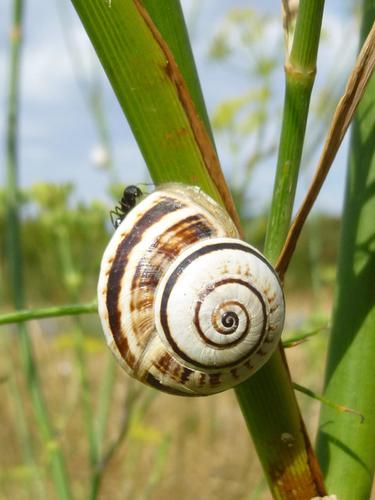当前位置:
X-MOL 学术
›
Ecol. Evol.
›
论文详情
Our official English website, www.x-mol.net, welcomes your feedback! (Note: you will need to create a separate account there.)
Experimental simulation of environmental warming selects against pigmented morphs of land snails
Ecology and Evolution ( IF 2.6 ) Pub Date : 2021-01-14 , DOI: 10.1002/ece3.7002 Heinz‐R. Köhler 1 , Yvan Capowiez 2 , Christophe Mazzia 3 , Helene Eckstein 1 , Nils Kaczmarek 1 , Mark C. Bilton 4 , Janne K. Y. Burmester 1 , Line Capowiez 2 , Luis J. Chueca 5, 6 , Leonardo Favilli 7 , Josep Florit Gomila 8 , Giuseppe Manganelli 7 , Silvia Mazzuca 9 , Gregorio Moreno‐Rueda 10 , Katharina Peschke 1 , Amalia Piro 9 , Josep Quintana Cardona 11, 12 , Lilith Sawallich 1 , Alexandra E. Staikou 13 , Henri A. Thomassen 14 , Rita Triebskorn 1, 15
Ecology and Evolution ( IF 2.6 ) Pub Date : 2021-01-14 , DOI: 10.1002/ece3.7002 Heinz‐R. Köhler 1 , Yvan Capowiez 2 , Christophe Mazzia 3 , Helene Eckstein 1 , Nils Kaczmarek 1 , Mark C. Bilton 4 , Janne K. Y. Burmester 1 , Line Capowiez 2 , Luis J. Chueca 5, 6 , Leonardo Favilli 7 , Josep Florit Gomila 8 , Giuseppe Manganelli 7 , Silvia Mazzuca 9 , Gregorio Moreno‐Rueda 10 , Katharina Peschke 1 , Amalia Piro 9 , Josep Quintana Cardona 11, 12 , Lilith Sawallich 1 , Alexandra E. Staikou 13 , Henri A. Thomassen 14 , Rita Triebskorn 1, 15
Affiliation

|
In terrestrial snails, thermal selection acts on shell coloration. However, the biological relevance of small differences in the intensity of shell pigmentation and the associated thermodynamic, physiological, and evolutionary consequences for snail diversity within the course of environmental warming are still insufficiently understood. To relate temperature‐driven internal heating, protein and membrane integrity impairment, escape behavior, place of residence selection, water loss, and mortality, we used experimentally warmed open‐top chambers and field observations with a total of >11,000 naturally or experimentally colored individuals of the highly polymorphic species Theba pisana (O.F. MÜLLER, 1774). We show that solar radiation in their natural Mediterranean habitat in Southern France poses intensifying thermal stress on increasingly pigmented snails that cannot be compensated for by behavioral responses. Individuals of all morphs acted neither jointly nor actively competed in climbing behavior, but acted similarly regardless of neighbor pigmentation intensity. Consequently, dark morphs progressively suffered from high internal temperatures, oxidative stress, and a breakdown of the chaperone system. Concomitant with increasing water loss, mortality increased with more intense pigmentation under simulated global warming conditions. In parallel with an increase in mean ambient temperature of 1.34°C over the past 30 years, the mortality rate of pigmented individuals in the field is, currently, about 50% higher than that of white morphs. A further increase of 1.12°C, as experimentally simulated in our study, would elevate this rate by another 26%. For 34 T. pisana populations from locations that are up to 2.7°C warmer than our experimental site, we show that both the frequency of pigmented morphs and overall pigmentation intensity decrease with an increase in average summer temperatures. We therefore predict a continuing strong decline in the frequency of pigmented morphs and a decrease in overall pigmentation intensity with ongoing global change in areas with strong solar radiation.
中文翻译:

环境变暖对蜗牛的色素变体选择的实验模拟
在陆地蜗牛中,热选择会影响外壳的着色。然而,在环境变暖过程中壳色素沉着强度的微小差异以及蜗牛多样性的相关热力学,生理和进化后果的生物学相关性仍未得到足够的了解。为了将温度驱动的内部加热,蛋白质和膜的完整性受损,逃逸行为,居住地点的选择,失水和死亡率联系起来,我们使用了经过实验加热的敞开式隔室和现场观察,总共有超过11,000名自然或经过实验着色的个体多态种Theba pisana(OF MÜLLER)(1774年)。我们表明,在法国南部其自然的地中海栖息地中,太阳辐射对越来越多的色素沉着的蜗牛构成了越来越大的热应激,这种行为无法通过行为反应来弥补。所有形态的个体在攀爬行为中既没有共同参与也没有主动参与竞争,但是无论邻居色素沉着强度如何,其行为都相似。因此,深色的形态逐渐受到内部高温,氧化应激和伴侣系统的破坏的影响。随着水损失的增加,在模拟的全球变暖条件下,死亡率随着色素沉着的增加而增加。在过去30年中,平均环境温度升高了1.34°C,与此同时,有色人种的死亡率目前比白色变种高约50%。如我们的研究中实验所模拟的,如果进一步提高1.12°C,该速度将再提高26%。对于34来自我们实验地点的最高温度为2.7°C的pi。pisana种群,我们发现,随着夏季平均温度的升高,色素变色的频率和总色素沉着强度都会降低。因此,我们预计随着强烈的太阳辐射区域的全球变化,色素变体的频率将持续大幅下降,总色素沉着强度将下降。
更新日期:2021-02-05
中文翻译:

环境变暖对蜗牛的色素变体选择的实验模拟
在陆地蜗牛中,热选择会影响外壳的着色。然而,在环境变暖过程中壳色素沉着强度的微小差异以及蜗牛多样性的相关热力学,生理和进化后果的生物学相关性仍未得到足够的了解。为了将温度驱动的内部加热,蛋白质和膜的完整性受损,逃逸行为,居住地点的选择,失水和死亡率联系起来,我们使用了经过实验加热的敞开式隔室和现场观察,总共有超过11,000名自然或经过实验着色的个体多态种Theba pisana(OF MÜLLER)(1774年)。我们表明,在法国南部其自然的地中海栖息地中,太阳辐射对越来越多的色素沉着的蜗牛构成了越来越大的热应激,这种行为无法通过行为反应来弥补。所有形态的个体在攀爬行为中既没有共同参与也没有主动参与竞争,但是无论邻居色素沉着强度如何,其行为都相似。因此,深色的形态逐渐受到内部高温,氧化应激和伴侣系统的破坏的影响。随着水损失的增加,在模拟的全球变暖条件下,死亡率随着色素沉着的增加而增加。在过去30年中,平均环境温度升高了1.34°C,与此同时,有色人种的死亡率目前比白色变种高约50%。如我们的研究中实验所模拟的,如果进一步提高1.12°C,该速度将再提高26%。对于34来自我们实验地点的最高温度为2.7°C的pi。pisana种群,我们发现,随着夏季平均温度的升高,色素变色的频率和总色素沉着强度都会降低。因此,我们预计随着强烈的太阳辐射区域的全球变化,色素变体的频率将持续大幅下降,总色素沉着强度将下降。



























 京公网安备 11010802027423号
京公网安备 11010802027423号